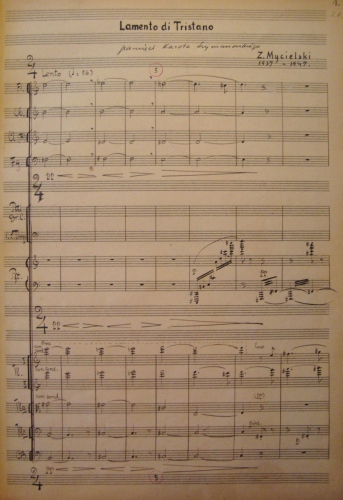Lamento di Tristano for small symphony orchestra (1937, rev. 1947)
instrumentation: fl, ob, cl B, fg, ptti, gr c, 2 tmpn, pfte, quintetto d’archi (6-6-4-3-2)
dedication: in memory of Karol Szymanowski
duration: ca 10’
edition: PWM 2018 (series: 100 for 100. Musical Decades of Freedom)
premiere:
1937 version: Vilnius, 27 May 1937, Symphony Orchestra, cond. Czesław Lewicki
1947 version: Kraków, 9 November 1947, Chamber Orchestra of the Kraków Philharmonic, cond. Andrzej Panufnik
The writing of Lamento di Tristano can be followed thanks to Zygmunt Mycielski’s correspondence with his mother Maria Mycielska née Szembek.
In successive letters sent from Vilnius the composer reported on his progress, at the same time specifying the genre of the new piece: “I’m writing […] something new for small orchestra” (11 February 1937); “I’m finishing my Lamento di Tristano. After 1 April I’ll go to make a fair copy to Orniany, where Miś [Count Michał Tyszkiewicz] will have a piano put in my room” (19 March 1937); “my sinfonietta will most likely be aired by the national radio in May” (29 March 1937). Mycielski added the following sentence to the last letter: “News on the radio about Karol Szymanowski’s death today”.
After Szymanowski’s funeral ceremonies, in which Maciejewski was actively involved, a decision was made to dedicate Lamento… in memory of Szymanowski. The first movement of the sinfonietta was premiered during a concert on 27 May 1937 in the Polish Radio Hall in Vilnius (Symphony Orchestra conducted by Czesław Lewicki). Mycielski was not satisfied with the performance:
Coming back to the performance of the first part of Tristano – they played badly; it was not so much a performance, but the fourth or even just third read through the score, and no one in the orchestra understood anything – good old Lewicki, the conductor, did not get much either – and few among the listeners did (2 June 1937).
The score of Lamento di Tristano went missing during the war and before the 6th Concert of the Polish Music Publishers during the Radio Festival of Slavic Music, held on 9 November 1947 (Chamber Orchestra of the Kraków Philharmonic conducted by Andrzej Panufnik), Mycielski reconstructed the pre-war version of the work.
The structure of Lamento is clear – the two main parts of the piece are held together by a small framework (introduction and postlude), which introduces symbolism associated with anguish, despair and suffering. The main movements, Piú mosso and Lento, resemble a fantasia composed of a series of themes in an allusion to the style of Szymanowski. The poetic vocal melodies, which use mainly steps of seconds and thirds, are tonally unstable (the composer subtly uses chromaticism in random steps). Mycielski presents them through polyphonic transformations, usually against a background provided by an ostinato accompaniment. Such a steps-resembling movement might have been a reference to means characteristic of the pavane, which in the fifteenth century became a stereotypical form for expressing sadness and lamentation (cf. Bogumiła Mika, Cytaty w muzyce polskiej XX wieku. Konteksty, fakty, interpretacje, Musica Iagellonica, Kraków 2008, p. 223).
There is an audible aura of Karol Szymanowski’s works in Lamento: aura of highlander folklore bringing to mind Stabat Mater, of the ballet Harnasie or the colouring use of the piano (like in the second movement of Szymanowski’s Symphony No. 4 “Symphonie concertante”). Thus Lamento di Tristano can be interpreted as a hommage or tombeau, as it were, in memory of a friend and master.
